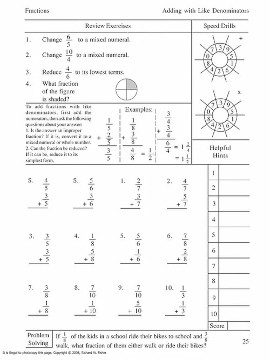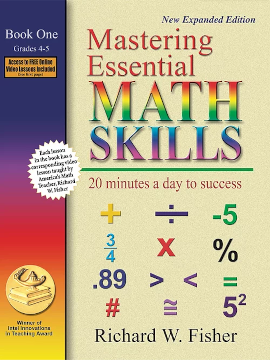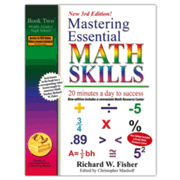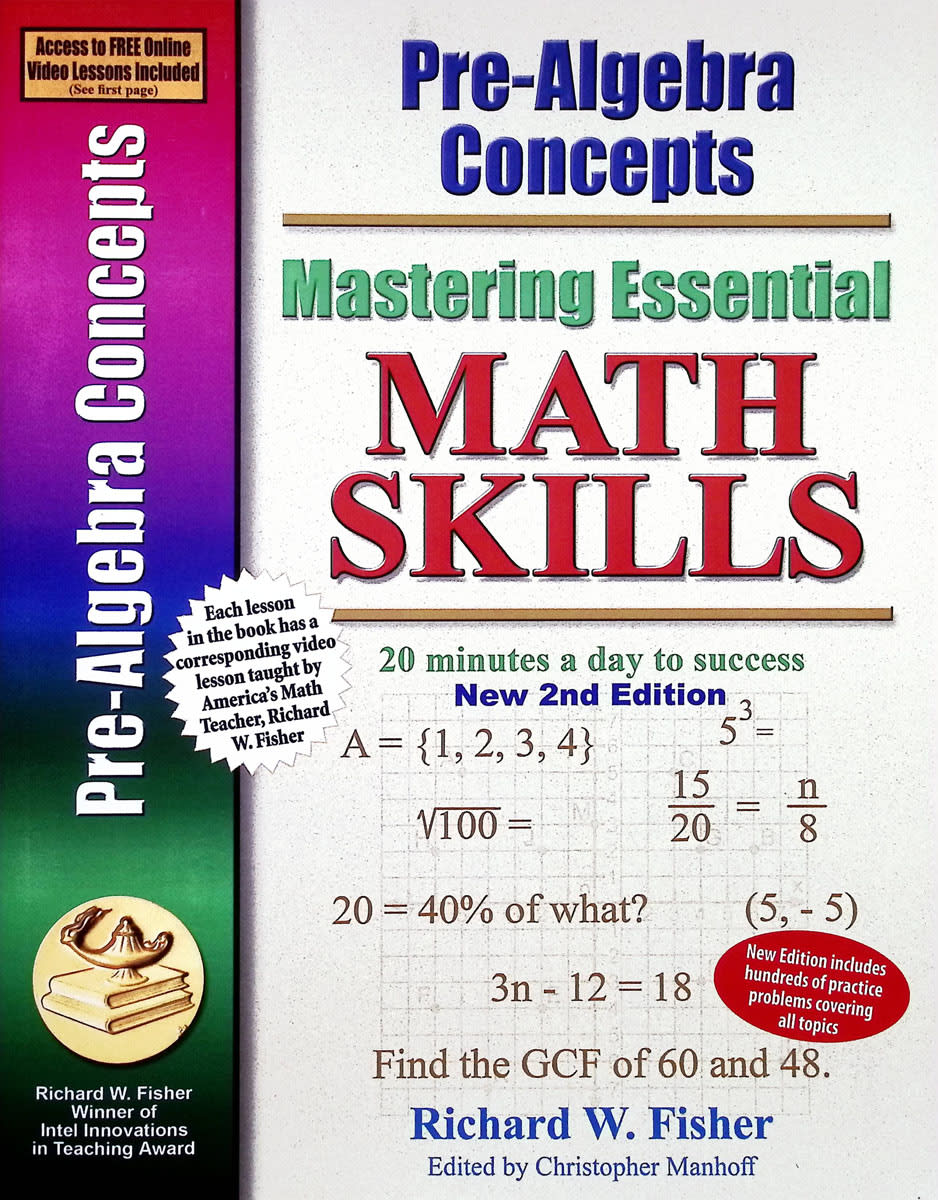In the Mastering Essential Math Skills series, Richard Fisher has written a number of math books that review core math concepts. Some of the books are available in either English or Spanish, and some books are also offered in bilingual editions that present identical lessons in both languages.
All of the books have free instructional videos available online for both English and Spanish versions. (You can purchase the videos on DVDs if you cannot access the online videos.) The videos are not a stand-alone resource but are dependent on the books.
Books in this series might be used with students as young as fourth or fifth grade and all the way up through high school for students who need remediation. All of the books I discuss in this review cover concepts that are normally taught up through about grades seven and eight—pre-algebra level. (Another course, titled No-Nonsense Algebra, which I review separately, can be used for high school math.)
The books are designed to reteach core concepts efficiently while also supplying review activities. The books all share a similar format, presenting each day’s lesson on one page. Each lesson begins with review problems. The first two books, Mastering Essential Math Skills: Book One and Book Two also include a unique feature for reviewing basic math facts for addition and multiplication. Daily speed drills have the numbers 0 through 9 arranged in a circle around a blank center. Spokes extending from the blank center separate the numbers and identify the space outside the circle for students to write the answers. The teacher tells students the number to write in the center of the addition circle first, and students then add that number to the surrounding numbers in turn, writing their answers as quickly as they can. The same thing is done for the multiplication drills.
 After students have completed their review problems (and speed drills in the first two books), the teacher introduces a new concept. Teaching instruction is extremely brief—presented as “Helpful Hints.” Some students might need additional instruction, and this is where the instructional videos come in. The videos vary in length but generally run from about five to ten minutes each. Fisher uses a whiteboard to teach each concept step by step. He sometimes uses problems that also appear in the books, and he advises students to work the problems with paper and pencil along with him. Students should work through the sample problems while watching the instruction, then they can return to their books to solve a set of problems on their own. One word problem is included at the end of every lesson except in those lessons that are entirely devoted to solving word problems.
After students have completed their review problems (and speed drills in the first two books), the teacher introduces a new concept. Teaching instruction is extremely brief—presented as “Helpful Hints.” Some students might need additional instruction, and this is where the instructional videos come in. The videos vary in length but generally run from about five to ten minutes each. Fisher uses a whiteboard to teach each concept step by step. He sometimes uses problems that also appear in the books, and he advises students to work the problems with paper and pencil along with him. Students should work through the sample problems while watching the instruction, then they can return to their books to solve a set of problems on their own. One word problem is included at the end of every lesson except in those lessons that are entirely devoted to solving word problems.
All of the lessons in each book begin with a set of review problems. A one-page "final review" at the end of each section includes problems from the entire section, such as a review on all fraction operations. Some books place an additional final review that serves as a test for each major section at the end of the book, and some books present them as tests immediately following the review at the end of a major section. The point is that regular assessment is built into each book.
The books all have numbered spaces for students to write their answers to the problems. Answer keys are near the back of each book. (Since the speed drills in the first two books allow the teacher to select the numbers to go in the center of each circle, there are no answer keys for them.) All of the books include a glossary and charts showing math aids such as multiplication tables, fraction/decimal equivalents, and squares and square roots.
The first two books are labeled as appropriate for certain ranges of grade levels: grades four and five for Book One and grades six through twelve for Book Two. However, you would not expect students at the low end of either grade range to be able to learn everything in the book that encompasses their grade level in that first year. For example, Book One includes coverage of fractions, decimals, percents, and ratios. While you might teach some of those topics in fourth grade, many should wait until fifth grade. The layout of the first two books actually makes them more appropriate for students beyond the first designated grade level, especially those who need review or remediation.
Neither book has enough content for a full-year math program. Book One has 143 pages of lessons and reviews while Book Two has 127. Book Two repeats most of the topics already covered in Book One but with different problems at a slightly more difficult level. It does not have a section on probability and statistics (which is included in Book One), and it has fewer lessons on charts and graphs than does Book One. On the other hand, Book Two adds one or two additional, more advanced subtopics under most of the other sections. Even with these differences, the content of each of the books is similar enough that you would be unlikely to use Two immediately after One.
Parallel Series
The other books in the series present content similar to that in Book One and Book Two in different formats. These are the titles of the other books, followed by the grade levels as shown on their covers:
- Mastering Essential Math Skills: Whole Numbers and Integers (grades 4 - 6)
- Mastering Essential Math Skills: Fractions (grades 4 - 6)
- Mastering Essential Math Skills: Decimals and Percents (grades 4 - 6)
- Mastering Essential Math Skills: Geometry (grades 4 - 6)
- Mastering Essential Math Skills: Problem Solving (grades 4 - 6)
- Mastering Essential Math Skills: Pre-Algebra Concepts (not designated but is grades 7 - 8)
- Basic Math Skills Rescue: Part 1 and Part 2 (grades 4 - 8)
I would think of the grade level designations as the years in which that content is usually taught. These books work well for remediation for students beyond those grade levels.
With the exception of Pre-Algebra Concepts, these books repeat the same topics that were taught in Book One and Book Two. A major difference is that each book has two lessons on every topic—double the number of lessons. The instructional information is almost identical to that in Book One and Book Two, although many of the problems are different. To make things more confusing, Basic Math Skills Rescue, Part 1 and Part 2 are compilations of the other six books in the preceding list. The entirety of the first three books are in Part 1 and the second three are in Part 2. This means that you have three different series of books from which to choose to cover all of the topics except pre-algebra.
You might choose Book One and Book Two if you want to include the speed drills. You might choose the individual topic books if you need to review only a few topics. You might choose the Basic Math Skills Rescue books if you need to review everything and want to save money by purchasing fewer books or because you just prefer the consolidation. And you might choose either of the last two options if you want students to have the option to spend two lessons on every topic.
The videos were designed to align with Book One, Book Two, and Pre-Algebra Concepts. Since, the topics are the same in all of the books (parallel series), those using the other books simply choose the videos that cover the same topics in the other books.
Summary
Many students need review or remediation for a number of reasons: a transition into homeschooling, spotty instruction in previous years, a struggle with learning particular concepts, illness, and so on. The Mastering Essential Math Skills series makes it easy to target particular skills with efficient lessons. The videos save parents from having to teach new concepts. In most cases, parents will simply need to check the student’s work. The books are reasonably priced, but when you take into consideration that students also have free access to videos for every lesson, these books are a real bargain.


















